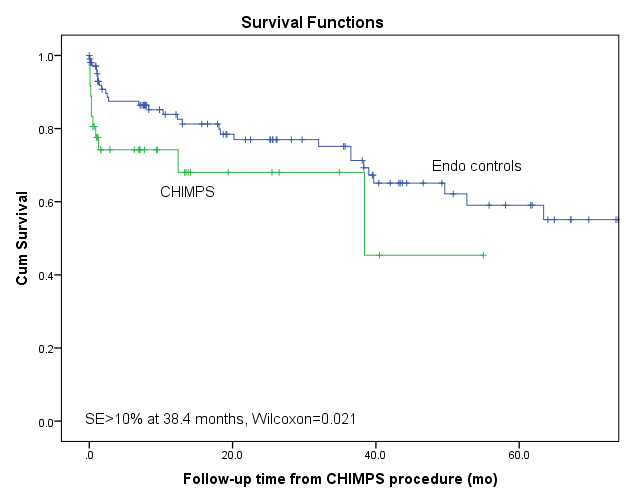Back to Annual Meeting Symposium
Experience with CHIMPS Endovascular Techniques and Outcomes in Comparison with Propensity Matched Controls
Zdenek Novak, MD, Benjamin J. Pearce, MD, Mark A. Patterson, MD, Thomas C. Matthews, MD, Marc A. Passman, MD, William D. Jordan, Jr., MD.
University of Alabama at Birmingham, Birmingham, AL, USA.
OBJECTIVES: Unsuitable endovascular anatomy presents a dilemma in patients at high risk for open aortic aneurysm repair. We reviewed our experience with off -label CHIMPS (CHIMney, Periscope, Snorkel) approach to treat complex aortic aneurysms and define outcomes among high risk aortic aneurysm patients.
METHODS: Retrospective analysis of all endovascular aortic procedures performed between 2000 and 2013 was performed to identify patients with CHIMPS endografts. CHIMPS patients were propensity matched to non-CHIMPS subjects by demographic and risk factors. Matched groups were compared for outcomes. Significance was statistically defined using χ2 (or Fisher’s exact test), t-test or Mann-Whitney U-test. KM analysis was used to compare survival.
RESULTS: The CHIMPS procedures were performed utilizing 57 branch stents in 38 patients (mean age 71.9±13.8 years). CHIMPS were used as initial endotherapy for 18 patients (47.3%). Indication for CHIMPS included aneurysm diameter 28 (mean 65±15mm), rupture 5, endoleak 2, dissection 1, dysphagia 1 and mycotic aneurysm 1. Twenty four procedures (63.1%) required single vessel stents, 10 procedures (26.3%) required two vessels, 3 procedures (7.8%) three vessels, and 1 procedure (2.6%) required four vessels. Intra-operative endoleak (EL) was observed in 18 patients (47.3%) (12 with T1, 1 with T2 and 5 with T3). At 30 days 7 of these resolved while one additional type 2 EL was observed. Of 57 total CHIMPS stents, 4 failed within 30 days (3 hypogastric and 1 celiac). Two additional hypogastric CHIMPS stents failed before 12 month follow up. No CHIMPS renal stents failed (n=14). Thirty-day mortality was 10.5% (4/38) in non-emergency cases and 18.4% (7/38) with emergency cases, compared to 1.8% (2/114) among matched EVAR patients. Among CHIMPS patients, 2 with mesenteric stents and intentional exclusion of renals initiated hemodialysis. Thirty day GFR estimates before and after procedures did not differ significantly between the groups. KM analysis shows decreased early survival but similar survival after 3 years in the matched cohort.
CONCLUSIONS: CHIMPS technique offers an alternative therapy in patients with complex aneurysmal disease judged to be medically unsuitable for open repair. Despite CHIMPS feasibility, these patients experience increased mortality compared to a propensity matched cohort.

Back to Annual Meeting Symposium

|


